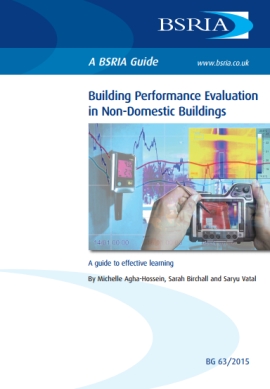Building performance evaluation in non-domestic buildings guide – an introduction to the tests and methods in non-domestic buildings
In September 2015, BSRIA published Building Performance Evaluation in Non-Domestic Buildings Guide – an introduction to the tests and methods in non-domestic buildings.
The guide provides a general introduction to Building Performance Evaluation (BPE), explains why it is important and how it can be carried out. BPE is a form of Post-Occupancy Evaluation (POE) which can be used at any point in a building's life to assess energy performance and occupant comfort and to make comparisons with design targets.
BPE is a key element of the BSRIA soft landings framework intended to help deliver buildings that are effective and efficient and perform as expected. The guide focuses on new, existing and refurbished non-domestic buildings and aims to inform those involved in the design, construction, operation and/or management of a building about its current performance.
The guide discusses some of the tests and methods that can be included when reviewing building performance to provide information about:
- Building fabric.
- Building services and operating strategies.
- Energy use.
- Handover and commissioning processes.
- Occupant satisfaction.
- Occupant comfort conditions.
It suggests that the following factors should be considered when structuring a BPE study:
- Management of building services.
- Nature of occupancy.
- Comfort and controls.
- Indoor air quality.
Catherine England, BSRIA Marketing Officer, said: “Despite genuine intentions to develop efficient buildings, the construction industry is still missing the mark. Recent research from academia and industry has shown that buildings do not always perform in the way that was originally intended. This results in inefficiencies in energy performance, and occupant dissatisfaction. BPE is the process of evaluating how a building performs and can be used on both new and existing buildings in order to address these issues. The publication captures this process.”
NB BSRIA suggest that, “Post-occupancy evaluation (POE) constitutes the activities of the BPE process once the building is occupied and in use, focussing on the operational performance and the occupants of the building. It is important to know to what extent the building maintains its occupants’ satisfaction and perceived comfort. To do this in a systematic and structured way, post-occupancy evaluation (POE) can be employed as a major part of BPE. This would involve collecting feedback (soft data) from the occupants through survey questionnaires, interviews and / or workshops, ideally at least one year after building occupation to cover at least on seasonal cycle.
--BSRIA
[edit] Related articles on Designing Buildings Wiki
- Building performance evaluation.
- Building performance evaluation in domestic buildings.
- Building performance metrics.
- Client commissioning.
- Defects liability period.
- Extended aftercare.
- Handover to client.
- Initial aftercare.
- Lessons learned report.
- Performance in use.
- Post occupancy evaluation.
- Post occupancy evaluation process.
- Post project review.
- Smart meters and building performance evaluation.
- Snagging.
- Soft landings.
- Soft Landings for owners.
Featured articles and news
The act of preservation may sometimes be futile.
Twas the site before Christmas...
A rhyme for the industry and a thankyou to our supporters.
Plumbing and heating systems in schools
New apprentice pay rates coming into effect in the new year
Addressing the impact of recent national minimum wage changes.
EBSSA support for the new industry competence structure
The Engineering and Building Services Skills Authority, in working group 2.
Notes from BSRIA Sustainable Futures briefing
From carbon down to the all important customer: Redefining Retrofit for Net Zero Living.
Principal Designer: A New Opportunity for Architects
ACA launches a Principal Designer Register for architects.
A new government plan for housing and nature recovery
Exploring a new housing and infrastructure nature recovery framework.
Leveraging technology to enhance prospects for students
A case study on the significance of the Autodesk Revit certification.
Fundamental Review of Building Regulations Guidance
Announced during commons debate on the Grenfell Inquiry Phase 2 report.
CIAT responds to the updated National Planning Policy Framework
With key changes in the revised NPPF outlined.
Councils and communities highlighted for delivery of common-sense housing in planning overhaul
As government follows up with mandatory housing targets.




















